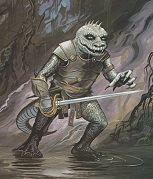|
i'd like some oil painting advice on getting brush strokes like you see in keevan donahue's stuff:  im brand new to painting and haven't really done anything creative since middle school, so i'm really trying to get my bearings with oil. i'm having a difficult time finding the right medium/ratio to keep a defined brush stroke. i've tried linseed oil and safflower, using hog bristle filberts, and it seems like i'm getting either too much or too little flow on the paint. i saw some advice that was basically "paint like a millionaire" and am i being too stingy with the paint? here's my first painting i've done:  i overblended and got a lot of mud in the skull, and my brushwork looks flat and overworked to me. i know most of my practice needs to center around my values and color matching but if i could get some advice on medium ratios to help me get the style i'm looking for i'd very much appreciate it.
|
|
|
|

|
| # ¿ Apr 24, 2024 19:51 |
|
Chernabog posted:That's actually pretty good for a first painting. I haven't used oils in years but I can give you some general painting tips. I appreciate it. I definitely think I'm going to continue working on it and try and get more definition in the detail in the box of weights and the book. I was having a really hard time not muddying everything up painting wet on wet but it's dry now so I can go work back over it now. I've done some reading and I think I'm using too heavy of a hand with the brush and it's over blending when I paint wet on wet. The black is mixed but I think you're right that there's too much and there should be some more tones in the background to make it interesting. Thank you for the advice.
|
|
|
|
que sera sera posted:I don't think the painter in your examples is using a ton of paint. It looks like he paints the backgrounds using using a thinner like mineral sprirts or galkyd, lets that dry, and then paints a thin layer over it, using a thinner to lift out additional color from the backgrounds. Stuff in the foreground is a bit thicker so you might not be able to do that alla prima. yeah, i've only been attempting alla prima up to this point and managing the paint feels extremely difficult. i'll try getting a couple of paintings started and coming back to them to build layers up like you described. thanks for the advice! HopperUK posted:I've been messing around with watercolour tutorials this weekend and my goodness I enjoy how little setup and teardown there is compared with oils. i've got a dedicated workspace that i installed an exhaust fan in so i haven't had a ton of setup or teardown. i found out sugar ants love safflower oil so i've got that going for me too. jarofpiss fucked around with this message at 12:59 on Apr 27, 2020 |
|
|





